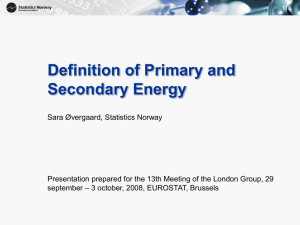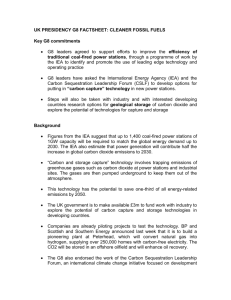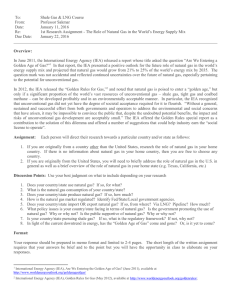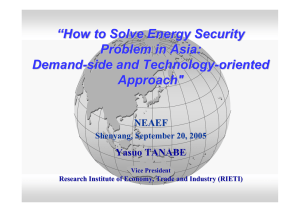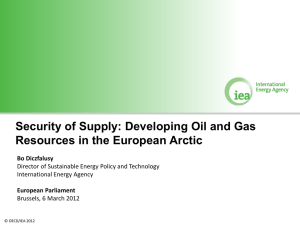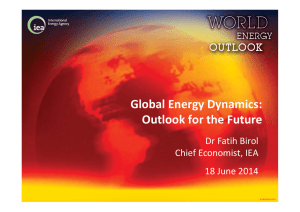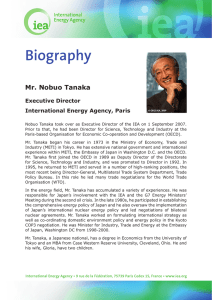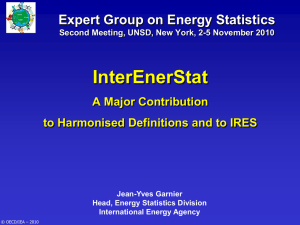The work of InterEnerStat and IRES from the
advertisement
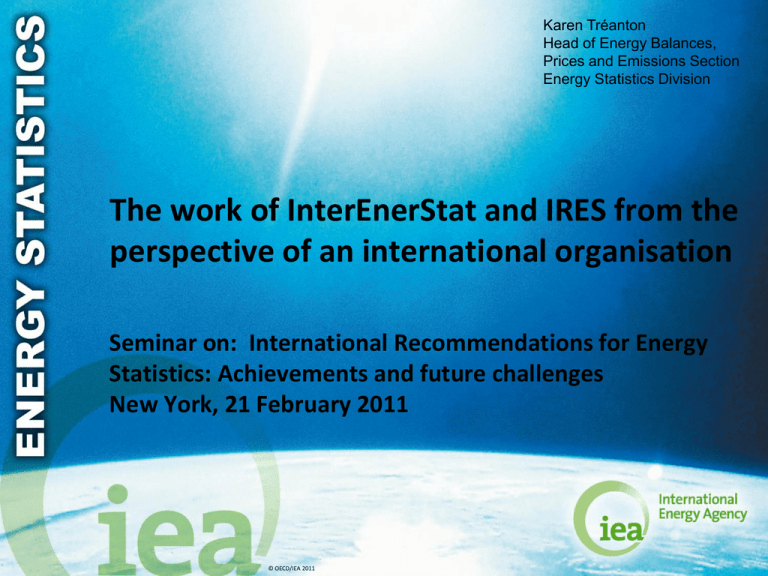
Karen Tréanton Head of Energy Balances, Prices and Emissions Section Energy Statistics Division The work of InterEnerStat and IRES from the perspective of an international organisation Seminar on: International Recommendations for Energy Statistics: Achievements and future challenges New York, 21 February 2011 © OECD/IEA 2011 Quality of energy statistics was deteriorating Completeness More and more data are estimated More and more data are missing and/or confidential Less and less details, more aggregation (CHP, main activity producers vs. autoproducers, …) Quality Efficiency of power plants > 100% Subtotals do not add up to totals Large statistical difference (>20%) Breaks in time series - no revisions in time series “Other sectors” often used as a balancing item Timeliness More and more time to collect, process, check and release data © OECD/IEA 2011 The reasons for decreasing data quality New developments make the tasks of statisticians much harder Liberalisation of the market From one company to hundreds Confidentiality (linked to liberalisation) More work passed to statistics offices: More companies to survey (liberalisation) Renewables (remote information) Energy efficiency indicators (including socio-economic data) Environment (estimation of GHG emissions, ….) Resources do not follow work load Statistics still have a low profile, budget cuts Fast turnover in staff: lack of experience, continuity © OECD/IEA 2011 Not only a lack of resources… also a lack of harmonization and co-operation An obvious need to react at all levels Secretaria de Energía Mexico UN Crude Oil Production for Mexico (in kbd) APEC IEA OLADE OPEC UN 1995 2653 2741 2722 2618 2834 1996 2903 2872 2969 2858 2977 1997 3087 3062 3022 3022 3166 1998 3134 3109 3070 3071 3250 © OECD/IEA 2011 Organisations started to react At the political level: Several presentations on the situation at the IEA Governing Board Transparency and statistics were also high on the agenda of the Ministerial Meeting in May 2005 Recognition/Commitment/Resources At the technical level: Release of an Energy Statistics Manual (together with Eurostat) Training of statisticians from Member / Non-Member countries A series of meetings with Member countries Expertise/Recognition/Commitment Creation of the OCG and the InterEnerStat © OECD/IEA 2011 The momentum was there….. IEA in consultation with UNSD decided to hold the 1st InterEnerStat meeting (Nov. 2005) Objectives: To hear from each organisation what they do, what are their problems and their expectation for more co-operation To pave the way for more harmonization and for strengthening bilateral and international co-operation Participants: 24 major regional and international organisations. Both data providers (IEA, UNSD, OPEC, Eurostat, FAO) and users (WB, IMF, UNFCCC,…) © OECD/IEA 2011 Two Clear Requests Harmonisation Methodologies Co-operation Definitions Raising political awareness Units Harmonisation Conversion factors Joint Questionnaires Harmonised demands and questionnaires Joint Training Common manuals Handbooks and manuals Joint quality assessment Training Exchange of data Quality framework © OECD/IEA 2011 Harmonisation: first step was to collect from each organisation its own set of definitions UN FAO OAPEC WORLD BANK OPEC The 2nd step was to assemble them in a transparent way easy to access © OECD/IEA 2011 Website presented at InterEnerStat 2 (Nov 2007) © OECD/IEA 2011 From InterEnerStat 2 to InterEnerStat 3 An expert was contracted to: Look at flows and products Highlight similarities and differences Propose a “compromise” definition for each flow/product © OECD/IEA 2011 3rd and 4th InterEnerStat meetings (Oct 2008 and Nov 2009) Expert provided first draft report for harmonised definitions Discussions with international organisations A series of decisions adopted Decisions translated into revised definitions © OECD/IEA 2011 Where is InterEnerStat now? By the end of 2010 all the minor outstanding points were agreed between groups working on InterEnerStat, OCG and IRES. These definitions will be guidelines to help organisations to arrive to a common understanding of what is a covered by a particular flow or a particular product. Definitions have been used in the International Recommendations for Energy Statistics manual of the UNSD, which is now going before the Statistical Commission… So, what next ? © OECD/IEA 2011 1. One questionnaire: dream or reality ? UN FAO AFREC OAPEC ? OPEC © OECD/IEA 2011 2. Provide better manuals The Joint IEA/Eurostat Energy Statistics Manual (now available in 10 languages) Arabic Farsi The IRES Manual (UNSD and Oslo City Group) (in cooperation with many organisations and countries) Manual on Energy Statistics for Energy Efficiency Indicators The Manual on Energy Statistics for Energy Efficiency Indicators (IEA, ODYSSEE, others) © OECD/IEA 2011 3. Joint trainings for energy statisticians Examples of recently conducted training sessions: IEA training centre (next week in Paris) Chile (in Santiago) South Africa (in Johannesburg) Energy Community (in Paris) Three Chinese secondees for 3 months The MEDSTAT programme Regular training for APEC economies (i.e. Bangkok) Several training sessions including on line training © OECD/IEA 2011 A few words to conclude Harmonisation will not happen overnight. It needs time, effort, resources and commitment. The first several steps have been taken to establish the basis for moving harmonisation forward. Underlying principle: evolution not revolution. The main objective is to support energy policy and energy analysis. Thank you © OECD/IEA 2011
